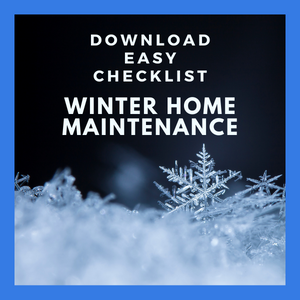Winter Home Maintenance Checklist: 10 Tips to Save Money
You know that getting your home ready for winter weather includes a list of unfun maintenance tasks. And because you’ve likely put them off, you probably need a little motivation. Here’s a bit of incentive: a winter home maintenance checklist saves money, not only in the winter but year-round.
Think of winterizing your home in layers. Some suggestions are easy— a quick trip to the store or an online order will take care of business. Other remedies will need a few days to plan and prepare. A combination of both achieves the most amount of savings in your energy bills.

Every little improvement helps; for example, reducing cold drafts in your home saves between 10% and 20% in energy costs each year, according to Energy.gov.
To familiarize yourself with all of the possibilities to increase energy efficiency and create short and long-term plans to save money, review the home energy audit that Energy.gov discusses. The video shows where to investigate energy loss, the tools you might need, and how to hire professionals if you’re interested.
However, if you’re ready to tackle these tasks yourself today, get to work on your interior and exterior winter home maintenance, happily check them off your list, and watch your savings grow.
Interior Winter Home Maintenance Fixes to Save Money
1. Insulate Windows and Doors
By far one of the worst offenders for eating away at your cash, inefficient windows and doors drive up heating costs each month. New installation is the ultimate solution, but until then, there are multiple inexpensive ways to beat the cold and drafts now:
- Window insulation or shrink film. Start with clean windows so the plastic will adhere correctly. Cut the plastic sheeting to customize the dimensions needed and affix it to the window glass with double-stick tape. A blowdryer shrinks the plastic to fit tightly. The light still streams in, but cold air is kept out.
- Rope caulk. Moldable and sticky, this type of caulk fills gaps and cracks in window casings.
- V-seal weather stripping. Sold in rolls, this plastic weather stripping is self-adhesive and attaches to the sashes of the windows. The foam or thick brush side of the tape closes the gaps. This product also works on doorframes.
- Draft guards and snakes. For a less permanent solution, draft snakes clog gaps with foam and fabric stuffing. Widely available for purchase, they come in a variety of sizes (the typical size is 36 inches) and feature washable fabric designs that either blend with the door or window sill or stand out to become part of the décor.
2. Inspect Fireplace Flue and Damper
An open fireplace flue is a significant source of heat escaping right out of your chimney. An importantn seasonal home maintenance chore is to verify that the damper opens, closes, and seals properly. If air continues to flow, insert a fireplace plug. A plug is an inflatable device that fits into the chimney to block the air from coming in or out.
3. Swap Lightweight Curtains for Heavy Material
Some people enjoy switching curtain fabric with the season simply to enjoy a new aesthetic, but thick material also traps heat inside. During clear, sunny days (if windows are properly sealed), open the curtains to let the light in and take advantage of natural heating.
 Photo by victor baiardi from Getty Images via Canva.com
Photo by victor baiardi from Getty Images via Canva.com
4. Protect Your Pipes with Insulation Sleeves
Installing foam insulation sleeves will you protect against future water disasters by avoiding freezing and cracking, while also keeping your pipes at a warmer temperature. This allows hot water to run faster and use less energy heating showers and baths.
5. Blanket Your Water Heater
Outdated heaters are inefficient and work hard to warm the water while racking up the extra money needed for energy bills. An insulation blanket also gives a boost to a heater that is located in a cold space.
6. Invest in a Stair Cover or Attic Stairway Insulator
You might not have thought about it—out of sight, out of mind after all—but the stairs leading to the attic have a built-in opportunity for heat to escape. Insulators come in a variety of draft-reducing materials and look like a tent. Choose one with a zipper for easy access to storage in the attic if needed.
Don't forget about these important annual and seasonal home maintenance tasks.
Exterior Winter Home Maintenance Fixes to Save Money
7. Check the Roof
If you feel comfortable with climbing on the roof, simple roof repairs help to conserve energy. Shingle repair, new caulking, and flashing all contribute to less cold air entering the house. Raking heavy snowfall from the roof discourages ice dams and unwanted weight from the structure.
8. Clean Gutters and Downspouts
By maintaining gutters and downspouts each season, you’ll avoid foundation and moisture problems in the future. During the winter, a clear system helps to prevent ice dams from blocking the flow of water. Take a good look at the health of the entire system and replace worn-out brackets and gutter hangers.
9. Check Dryer and Bathroom Vents for Airflow
Although the area around these entrances will probably be small, a quick caulk circle ensures little air penetration, and you’ll also close off even the tiniest spaces, which discourages pests from entering the home.
You can never be too cozy! See these 10 Easy, Low-Cost Ideas to Keep Your Home Warm This Winter.
10. Add Insulation to Your Attic
One of the best returns on your energy investments is ample insulation in your attic. It prohibits expensive heat from moving right through the roof. Insulation helps in the warm months, too, keeping cool air downstairs where it should be. Insulation also helps with overall mitigation against ice dams and icicles.
Although each winter home maintenance fix might not be attainable or affordable immediately, all checklist options offer ways to save money. You’ll need to strategize which solutions yield the greatest results within your current budget. Take note: if you plan to tackle a big project, like additional insulation in the attic, talk to multiple professionals, as some offer discounts for an off-season installation.





